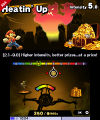Classic Mode (SSB4-3DS): Difference between revisions
Serpent King (talk | contribs) mNo edit summary |
No edit summary |
||
| Line 1: | Line 1: | ||
{{ArticleIcons|ssb4-3=y|protected=preemptive}} | {{ArticleIcons|ssb4-3=y|protected=preemptive}} | ||
{{cleanup|Split cleanup}} | {{cleanup|Split cleanup}} | ||
{{move|Classic mode (SSB4-3DS)|Not capitalised in-game}} | |||
In the ''3DS'' version, Classic Mode underwent a huge revamp: instead of following a singular path as per previous games, the player is now given a choice of routes to follow, providing different opponents along the way. | In the ''3DS'' version, Classic Mode underwent a huge revamp: instead of following a singular path as per previous games, the player is now given a choice of routes to follow, providing different opponents along the way. | ||
Revision as of 00:23, April 22, 2015
In the 3DS version, Classic Mode underwent a huge revamp: instead of following a singular path as per previous games, the player is now given a choice of routes to follow, providing different opponents along the way.
Each path is marked by a series symbol, representing a battle set in a stage from that universe against at least one character from it (with the possibility of more characters from unrelated ones), and a color denoting the battle's difficulty: red indicates a path to more rewards but a harder difficulty, green indicates a medium level of difficulty with moderate rewards, and blue indicates the easiest battle with little reward. The final path to Master Hand is uniquely colored white. On each path, gold and sometimes trophies can be picked up before the battle.
All of one-on-one, 2-on-2, Metal, Giant, and four man free-for-all battles return, the last taking place on one of the characters' home stage. Unlike previous Classic Modes, returning stages are playable in the mode. Multi-Man battles also return, either against a normal character or a Fighting Mii Team, but this time they always are the last round before Master Hand.
Winning a match rewards the player with gold, as well as additional gold, Custom Parts, or Trophies as randomly selected beforehand (in multiples of 0-5).
Instead of selecting an amount of stock to carry throughout an entire run, players always start each stage with 2 stock regardless of difficulty. The difficulty selection was also changed to the Intensity system, very similar to the Fiend's Cauldron in Kid Icarus: Uprising, which allows players to invest gold to either raise or lower the difficulty, and with it the possible rewards. The basic intensity, which requires no gold to access, is 2.0; it can be lowered to 0.0 or raised to 9.0.
In addition to the overall difficulty, the intensity influences the final boss: while Master Hand is the basic final boss, more options can be unlocked at higher intensities. On an intensity of 3.0 or higher, a second, black path is unlocked which leads to a battle with both Master Hand and Crazy Hand. If the intensity is 5.1 or higher, the battle with the two hands will begin as usual, but after taking enough damage, they will transform into the new boss Master Core, which possesses several forms and whose starting form is more advanced the higher the intensity. If the intensity is 8.0 or higher, the black path is the only final path.
Rewards
- Clearing Classic Mode on any difficulty with any character will give the player a trophy of the character used.
- Clearing with any character on any difficulty will challenge the player to defeat Ness. Beating him will unlock him.
- Clearing with any character on any difficulty without using any continues will challenge the player to defeat Falco. Beating him will unlock him.
- Clearing with three or more characters will challenge the player to defeat Dark Pit. Beating him will unlock him.
- Clearing with eight or more characters will challenge the player to defeat Duck Hunt. Beating them will unlock them.
- Clearing with ten or more characters will challenge the player to defeat Mr. Game & Watch. Beating him will unlock him.
- Clearing with Marth without using any continues will challenge the player to defeat Lucina. Beating her will unlock her.
- Clearing with Mario on intensity 4.0. or higher will challenge the player to defeat Dr. Mario, and beating him will unlock him.
- Clearing with Link or Zelda on intensity 5.0. or higher will challenge the player to defeat Ganondorf, and beating him will unlock him.
- Clearing with Bowser on intensity 6.0. or higher will challenge the player to defeat Bowser Jr., and beating him will unlock him.
Challenges
Board 1
- Clearing with any character on any difficulty and defeating Ness will unlock the Magicant stage.
- Clearing with three or more characters and defeating Dark Pit will unlock the "Dark Pit Staff" trophy.
- Clearing on intensity 3.0 or higher with any character will give the player the song for Master Hand.
Board 2
- Clearing with ten or more characters and defeating Mr Game & Watch will unlock the Flat Zone 2 stage.
- Clearing after defeating Master Core will give the player the song for Master Core.
- Clearing with five characters will unlock the "Master Hand" trophy.
Board 3
- Clearing on intensity 9.0 will unlock the "Guardian" trophy.
- Beating Classic Mode with all characters will unlock the "Crazy Hand" trophy.
Gallery
Classic Mode in Super Smash Bros. for Nintendo 3DS.






